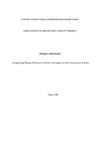Somali exodus slows in Horn of Africa but grows in Yemen
The number of people fleeing their homes in Somalia has been falling this month, but a growing number are risking the high seas to reach Yemen.

Members of an extended family arrive in the Somali town of Galkayo after fleeing their home earlier this year because of drought. © UNHCR/R.Gangale
GENEVA, August 26 (UNHCR) - The number of people fleeing their homes in Somalia on a daily basis has been falling this month, but a growing number of Somalis have been risking the high seas to reach Yemen.
In Somalia, figures compiled by a network of UNHCR partners show a significant drop in the number of people arriving in Mogadishu. UNHCR spokesman Adrian Edwards told journalists in Geneva on Friday that the influx of internally displaced people into the Somali capital had peaked in July, when nearly 28,000 fled to the city in search of humanitarian help after fleeing famine, drought and conflict in the countryside.
"However, since the beginning of this month, just over 5,000 displacements into the city have been recorded. The average daily arrival rate in the city dropped from more than 1,000 per day last month to an estimated 200 in August," Edwards said.
Due to insecurity, almost no movements or returns were recorded in districts of Mogadishu held by the Al Shabaab militia until earlier this month. Furthermore, there are no livelihood opportunities and most of these areas were destroyed by previous fighting. African Union peacekeepers have also imposed restrictions on civilian movement or return to previously Al Shabaab-controlled areas.
"We are also seeing reports of Al Shabaab continuing to place restrictions on movement in areas under its control, particularly movements of men - most notably in the Lower Shabelle and Bay regions in the wake of the Al Shabaab withdrawal from the capital on August 6. This has prevented large population movements, especially from Lower Shabelle, into Mogadishu," Edwards said.
Meanwhile, donations from the Somali diaspora and mobilization by local and host communities in July and August to assist the affected populations during the Islamic fasting month of Ramadan may have enabled people to remain where they were.
"Furthermore, international and local organizations, including UNHCR, have been better placed to deliver aid to famine-affected populations in Bay, Gedo, south Bakool and Hiraan regions, particularly in areas along the Kenya and Ethiopia borders," Edwards said. "This has helped to reduce the pressure on Mogadishu as a destination to seek aid," he added.
UNHCR this week completed the distribution of 3,000 emergency assistance packages for up to 18,000 people in the Hiraan region, which is under Al Shabaab control.
The pace of arrivals of Somali refugees in neighbouring Kenya's Dadaab region has also slowed this month to 1,000-1,200 a day from 1,500 previously. But the overall health state of the latest arrivals, particularly the children, is worse than previously - reflecting the drought and hunger situations inside Somalia. The camps at Dadaab now house almost 500,000 people.
"Bucking the trend of the slowing outflow in the Horn of Africa, Yemen is seeing a sharp rise in the number of Somali refugees arriving on rickety boats across the Gulf of Aden. More than 3,700 Somali refugees have reached Yemen's coast so far in August," said UNHCR's Edwards.
This marks an earlier than normal start to the traditional peak season for smugglers' boats to arrive from Bossaso in northern Somalia, and is the highest monthly arrival rate so far this year. "The new arrivals tell our staff they fled Somalia because of the unstable security situation, severe drought, high food prices and lack of job opportunities," Edwards noted.
It is testament to the refugees' desperation that they have chosen to flee to Yemen, which is itself affected by serious unrest. They cross the Gulf of Aden on what are often unseaworthy and overcrowded boats. Many do not survive the dangerous crossing.
On Monday, two Somalis drowned when their boat capsized. Nonetheless, more Somalis are expected to arrive in Yemen in the coming months. Yemen hosts the second-largest population of Somali refugees in the region, with nearly 192,000. Some 15,000 of them have arrived since January.
Crisis in Horn of Africa
Related news and stories
Thousands of newly arrived Somali refugees in Ethiopia relocated to new settlement
Samira's Story
Drought brings life-threatening food shortages for refugees in Ethiopia
100,000 new Somali refugees arrive in Ethiopia in the past month, UN and partners are calling for urgent funding
Q&A with Mary Maker, UNHCR's newest Global Goodwill Ambassador
UNHCR teams and partners rush assistance to some 100,000 newly arrived Somali refugees in hard-to-reach area of Ethiopia
Your search for « dadaab » matched 1263 results. Only the first 1,000 results are displayed. Displaying page 1 of 112 pages.
-

Evaluation of the Dadaab firewood project, Kenya
15 Jun 2001 ... AND POLICY ANALYSIS UNIT Evaluation of the Dadaab firewood project, Kenya By CASA Consulting, ......... 13 Overview of the Dadaab Firewood Project......... -

Analysis of Refugee Protection Capacity: Kenya
18 Apr 2005 ... ... In 1998, these were consolidated into four refugee camps: the three Dadaab camps in the ... Somali refugees comprise the majority of the 138,571 refugees in the Dadaab camps. The Kakuma camp ...... -

Safe Haven: Case Study, Kenya
May 2013 ... ... / 22 Dadaab Refugee Camps / 22 Kenya’s Post-election Violence / 23 iv. findings / 25 Shelter Models / 25 Kakuma Refugee Camp / 28 Text Box: Dadaab Refugee ...... -

Strengthening refugee protection, assistance and support to host communities in Kenya: Project proposals
1 Aug 2008 ... according to international standards at the Dadaab camps……..9 3) Building the capacity of the ... access to a basic education of high quality at Dadaab refugee camps……………………………...... -

Vital links in social security: Somali refugees in the Dadaab camps, Kenya, Cindy Horst
10 Apr 2001 ... in social security: Somali refugees in the Dadaab camps, Kenya Cindy Horst University of ... 1991, three refugee camps were set up close to Dadaab, a small town in the Garissa district of ...... -

ILO-UNHCR Partnership through Technical Cooperation: Multi-bilateral Programme of Technical Cooperation: Self-reliance and sustainable livelihoods for refugees in Dadaab and Kakuma camps
1 Sep 2005 ... REPORT Self-reliance and sustainable livelihoods for refugees in Dadaab and Kakuma camps Alfred Dube (Kakuma) Andreas Koenig (Dadaab) The views expressed in this report are those of its author and ...... -

UNHCR fears fighting could swell numbers of Somalis fleeing into Kenya
11 Aug 2006 ... DADAAB, Kenya, August 11 (UNHCR) - Somali refugees are arriving at Dadaab in north-east Kenya at a rate of 100 per day, but UNHCR fears the numbers could rise even higher if fighting between the Union ...... -

Return intentions survey
17 Sep 2015 ... Nations High Commissioner for Refugees (UNHCR) Dadaab Refugee Operation, Nairobi Kenya and the ... Following this initial support the IOM Dadaab Survey Team carried on the survey that was financially ...... -

How To Guide: Reproductive Health in Refugee Situations, Kakuma & Dadaab, Kenya
1 Jun 2001 ... Her assessment of RH services in Kakuma and Dadaab refugee camps was undertaken with the aim of ... the reproductive health (RH) services provided in the refugee camps in Kakuma and Dadaab, Kenya. ......
